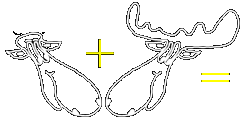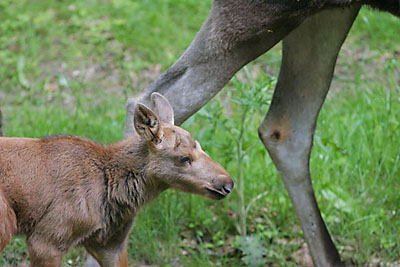
 |
Family bands and |
Moose are usually solitary animals. This changes for the following
reasons:
- Before the rutting season bulls meet for sparring matches
- Starting September cows gather in groups
- During mating season the bulls are quite interested in cows (of course), they
battle with other bulls
- After the rut bull moose "father-groups" can be set up for some time
- During winter time they might form into small groups
- Cows keep together with their calves for at least one year
Some more information on moose behaviour can be found in " Behaviour - to and of moose"
![]() Where do the small moose come from - The rut/mating season
Where do the small moose come from - The rut/mating season
During the rut in late September/early October (approximately
26.Sep.-10.Oct) both sexes attract
each other by calling over long distances up to half a kilometer, the cow
has a distinctive mating call she uses nearly all day long, while the bulls
sounds like a low frequency gulping or croaking. The element banding together is the smell
though, i.e. pheromones contained in urine and saliva.
Usually the mating seasons takes about 3-5 weeks, bulls move over 40 km to
reach the cows.
The bull moose is interested in cows after finishing the sweeping of his antlers free from the dead velvet, around August 25th. Before that time is reached, they train themselves in sparring fights, where also an early ranking between the bulls takes place. Some information on the symbolism, threatening and fighting of bulls can be found under" The antlers - more than just decoration"
The cows
are receptive for just around 3-12 days, this cycle can repeat at intervals of around
2-3 weeks (2-3 times), until they are pregnant. Real conception seems only to be possible during 1 to max
2 days in those 3-12 days. The peak estrus is seen around October 1st. The zenith of cow pursuit is the time from September
11th to 25th.
Sexual attractions of the bulls are the bell (oligatory, but likely
mainly visual), the strong urine smell also on head, antlers, neck and underside and the
antlers. Highly sensitive with a special "rut" smelling area in the
palate he can also detect oligatory signs from the cows (Pheromons
contained in their urine at that time). (Please see also "
Size,
Weight and More" in the sections for senses). Cows are highly attracted
by the urine/saliva smell of the bulls (containing pheromones). The bulls
also give audible information by trashing bushes several times per hour.
During the rut bulls use their special smelling organ in the roof of their mouth to detect the
direction and readiness for pairing of close-by cows. This Jabobson's or
vomeronasal organ is
revealed by lip-curling and head-lifting of the bull ("flemen").
With this organ they "analyze" any airborne pheromones or female urine, which they let flow over
nose and muzzle and by lifting and shaking the head it reaches this specialized
smelling organ. Not very appetizing for us, but common for deer.
|
The bull digs a hole (wallow/pit) about 5 times a day with his forelegs and antlers and urinates into it - a pretty strong smell. Then he strikes with the forelegs into the wallow and turns the head closer to "parfume" himself and his bell. Finally he lays down completely in the wallow. If the cow is close, she also puts herself inside and even protects it against other cows. It's not silent that time either - the cow utters nasal mating calls like a long, wailing moan, the bulls tends more to a caughing like barking. Younger bulls do not smell that strong and are therefore not that attractive to cows, so they and often use wallows of larger bulls to cheat. Just before the mating the bull puts his head on the cows back. Male and female get (sexually) mature in their second , partly third year of age. Bulls are usually later mature, so tend more to the third year of their life, although sometimes even yearlings can breed. Cows average maturity is reached with 16 months already. |
|
Bulls are polygamous, but usually start breeding not before the fifth year because of the natural order between the males. Also the cow can reject a youngster, preferring a prime bull, if available. A "top-bull" can have a harem of 5-8 cows in one season, although only one at a time. He can have several dozen matings in 2-3 weeks.
After the four weeks of mating the bulls relax in order to gain strength and to heal the wounds for the upcoming winter. He has left up to 25% of his weight during this stressful period where they stop feeding (only resuming gradually during the peak of the rut). Smaller bulls and cows continue feeding.
Older cows might also skip the rut cycle in order to stay longer with their yearling. They also might re-adopt a yearling driven off when the newborn claf dies.
![]() Where do the small moose come from - Birth and getting adult
Where do the small moose come from - Birth and getting adult
After mating in late September and early October, when around 90 % of
the cows are pregnant, it takes around 231 days until commonly
1-2 calves, sometimes also 3 are born around late May / early June next year.
Very few cases show even quadruplets born. Young
moose cows usually give life to 1 calf, while older cows can have 2
offspring. Additionally important for the number of offspring is the
availability of food: The likelihood for twins is 75% in really good feeding
conditions and drops to 2% in really bad one. This can be explained also by the
point, that in good conditions one calve would get to too large and could harm
the cow at birth or could get harmed itself. In average the twin-rate is about
30 %. Only about 50% of all mature cows give birth each year.
In Algonquin Provincial Park in Ontario the twin birth rate fluctuated from
7-80% within 10 years.
For the birth the cows seek a calm, secluded area.
The new calf/calves are totally helpless, but protected by a very
attentive mother charging bull moose, humans and bears by striking with their
front feet. During the first weeks the calves are banded to and imprinted from
their mother, who never moves more than 50 meters away from the place of birth
in the first week. Unlike other members of the deer family moose cows do
not hide their offspring: "Stand and fight" - just like bears do.
|
|
The cow educates them for 12-14 months in feeding, predators and survival. Nevertheless the death rate is around 50% in the calves first year. Already after some days the newborn can run faster than a human - and they learn swimming to gain some additional possibility to escape predators. Mother and newborn identify each other by their unique scent. |
|
She is raising the calves alone and has four nipples for feeding the newborn with a very nutritious, fat-rich milk which gets the calves growing with higher speed than many other mammals. The milk contains up to 24% rigid contents and is two times more concentrated than normal cow milk. Up to 10 times a day, the calves drink up to 2 litres a day! |
 |
The cow lactates the calves for around 4-5 months, they start eating normal moose food after 1 month, sometimes even after a few days. As new-borns they cannot digest normal browse, as they still lack the necessary bacteria in their stomachs. Those essential bacteria the calf receives his mother's saliva - either directly, by nibbling on leaves their mothers had browsed on, or from their mothers droppings.
The 90cm long and tall calves weigh 10-16 kg at birth (6-8 kg in case of twins) and have a wooly, soft, reddish-brown fur
with a darker muzzle and black circled eyes at that time, which changes after some weeks into a brigther russet. At that time also
the short muzzle begins to shape into to typical long moose nose. The first change of
fur is finished after around 15 weeks, the calve looks like his mother.
The calf gains 50 to 100 grams a day in the first weeks, then speeds up to a
maximum of over 2 kg!
per day after approx. 6 weeks.
After next mating season the calves don't get milk any more.
After around five months in autumn they have reached 120-200 kg already, and stop growing for the winter time, until they take up speed again in next spring to reach in autumn next year over 300 kg.
Even during the upcoming rut
the calf stays close to the cow - a small, temporary moose family. The mother usually drives off the calves
1-2 weeks before new offspring is born the coming year. The yearling will shadow
the mother for a while and will seek fellowship with other yearlings or bulls
later on.
In case she looses the
new offspring she can "re-adopt" the yearling again for another year
in order to improve his chances of survival.